by Jan Goodwin
February 27, 1998 –Thirty-thousand men and boys poured into the dilapidated Olympic sports stadium in Kabul, capital of Afghanistan. Street hawkers peddled nuts, biscuits and tea to the waiting crowd. The scheduled entertainment? They were there to see a young woman, Sohaila, receive 100 lashes, and to watch two thieves have their right hands amputated. Sohaila had been arrested walking with a man who was not a relative, a sufficient crime for her to be found guilty of adultery. Since she was single, it was punishable by flogging; had she been married, she would have been publicly stoned to death.
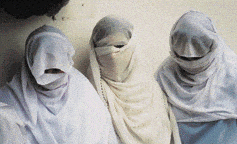
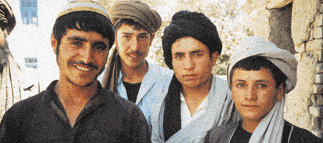
As Sohaila, completely covered in the shroud-like burqa veil, was forced to kneel and then flogged, Taliban “cheerleaders” had the stadium ringing with the chants of onlookers. Among those present there were just three women: the young Afghan, and two female relatives who had accompanied her. The crowd fell silent only when the luckless thieves were driven into the arena and pushed to the ground. Physicians using surgical scalpels promptly carried out the amputations. Holding the severed hands aloft by the index fingers, a grinning Taliban fighter warned the huge crowd, “These are the chopped-off hands of thieves, the punishment for any of you caught stealing.” Then, to restore the party atmosphere, the thieves were driven in a jeep once around the stadium, a flourish that brought the crowd to their feet, as was intended.
These Friday circuses, at which Rome’s Caligula would doubtless have felt at home, are to become weekly fixtures for the entertainment-starved male residents of Kabul. Now that “weak officials” have been purged from key ministries, says the city’s governor, Manan Niazi, who like many of the regime’s officials is also a mullah, the way has been cleared for such displays. “We have a lot of such unpunished cases, but the previous civil servants didn’t have the courage to do what we are doing. These people have now been replaced, and these events will continue.” In fact, the next scheduled program, as announced, would be one stoning to death and three amputations.
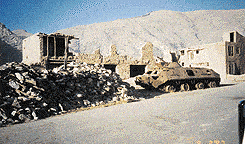
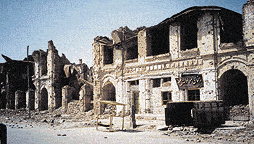
Earlier that same week, three men accused of “buggery” had been sentenced to death by being partially buried in the ground and then having a wall pushed over on them by a bulldozer, a bizarre and labor-intensive form of execution dreamed up by the supreme leader of the Taliban, the 36-year-old Mullah Mohammad Omar. After another man, a saboteur, was hanged, his corpse was driven around the city, swinging from a crane. Clearly, there is nothing covert about the regime’s punitive measures. In fact, the Taliban insure they are as widely publicized as possible. Last March, for example, the regime’s radio station, the only one permitted to operate, broadcast to the nation that a young woman caught trying to flee Afghanistan with a man who was not her relative had been stoned to death. On another occasion, it was announced over the airwaves that 225 women had been rounded up and sentenced to a lashing for violating the dress code. One woman had the top of her thumb amputated for the crime of wearing nail polish. And when the Taliban castrated and then hanged the former communist president and his brother in 1996, they left their bloodied bodies dangling from lampposts in busy downtown Kabul for three days. Photographs of the corpses appeared in news magazines and newspapers around the world.
The Taliban now control between 65 and 85 percent of Afghanistan, a country where statistics are anyone’s guess. (Even the population size of Afghanistan is uncertain: possibly 15, maybe 22 million. The U.S. Department of State’s figure on war fatalities-1.5 million- has not changed since 1985, although the armed conflict there is now in its 19th year.) For the last two years, the Taliban have been trying to win both a seat at the United Nations and international recognition. Thus far, only three countries have recognized the regime: Pakistan, the United Arab Emirates, and Saudi Arabia. And even Pakistan is becoming embarrassed by its neighbor.
Until the Taliban came to power, Saudi Arabia was the most oppressive country on earth for women, and many of the Taliban’s restrictions are rooted in that hardline Gulf state’s gender apartheid. Saudi Arabia has also been financially supportive of the Taliban and the religious schools in which they are indoctrinated. “We have long regarded the Saudi kingdom as our right hand,” says the head of the Taliban governing council.
The Taliban regime claim they are restoring Afghanistan to the “purity of Islam,” and the Western press invariably parrots them. But authorities in a number of Muslim countries insist that few of the regime’s dictates have a basis in Islam. And just as the U.N. has denied the Taliban a seat in the General Assembly, so too, the Organization of Islamic Conference, a 55-country body, has withheld both a seat and recognition from the regime. “The Taliban is not the image the Islamic world wants to project,” says one Muslim diplomat. And with good reason.
Now in its fourth year of existence, the pariah regime has expunged all leisure activities. Their list of what is illegal grows daily: music, movies and television, picnics, wedding parties, New Year celebrations, any kind of mixed-sex gathering. They’ve also banned children’s toys, including dolls and kites; card and board games; cameras; photographs and paintings of people and animals; pet parakeets; cigarettes and alcohol; magazines and newspapers, and most books. They’ve even forbidden applause — a moot point, since there’s nothing left to applaud.
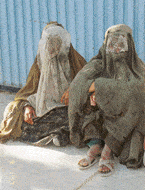
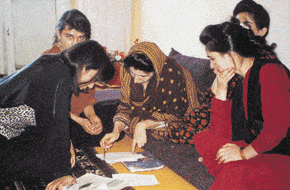

“Whatever we are doing in our country, it is not in order for the world to be happy with us,” Sher Abbas Stanakzai, who until recently was the Taliban’s 36-year-old deputy Minister of Foreign Affairs, told me during my visit. Explaining why his regime has banned virtually all forms of entertainment, he says, “Time should be spent serving the country and praying to God. Nothing else. Everything else is a waste of time, and people are not allowed to waste their time.”
For women, the restrictions are even harsher. Female education, from kindergarten through graduate school, banned. Employment for women, banned. It’s now illegal to wear makeup, nail polish, jewelry, pluck your eyebrows, cut your hair short, wear colorful or stylish clothes, sheer stockings, white socks and shoes, high-heel shoes, walk loudly, talk loudly or laugh in public. In fact, the government doesn’t believe women should go out at all: “Women, you should not step outside your residence” reads one of the Taliban dictates.
If women do venture out, it must be for an essential, government-sanctioned purpose, and they must wear the all-enveloping burqa. Even then they risk their lives. Not so long ago, a young mother, Torpeka, was shot repeatedly by the Taliban while rushing her seriously ill toddler to a doctor. Veiled as the law requires, she was spotted by a teenage Taliban guard, who tried to stop her because she shouldn’t have left her home. Afraid her child might die if she were delayed, Torpeka kept going. The guard aimed his Kalashnikov machine-gun and fired several rounds directly at her. She was hit, but didn’t die on the spot, as she could have. Instead, Afghans watching the incident in the crowded marketplace intervened, and Torpeka and her child received prompt medical attention. When her family later complained to the Taliban authorities, they were informed that it was the injured woman’s fault. She had no right being out in public in the first place.
The burqa is a garment that covers women from head to toe, the heavy gauze patch across the eyes makes it hard to see, and completely blocks peripheral vision. Since enforced veiling, a growing number of women have been hit by vehicles because the burqa leaves them unable to walk fast, or see where they are going. Recently in Kabul, a Taliban tank rolled right over a veiled woman. Fortunately, she fell between the tracks. Instead of being crushed to death, she was not seriously hurt, but was severely traumatized.
To insure women are effaced as effectively as if they never existed, the government ordered all exterior windows of homes to be painted black. The only public transport permitted women are special buses, which are rarely available, and have all windows, except the driver’s, covered with thick blankets.
It is now illegal for women to talk to any men except close relatives, which precludes them from visiting male physicians, no matter how sick. At the time of my recent visit, the evening curfew began at 7:30 p.m., after which no one, except government troops, was allowed out, even for medical emergencies. Even women in labor and needing hospital care must remain at home until morning.
It would probably be quicker to list what the Taliban haven’t banned. The regime has even outlawed paper bags. Like many of their edicts, this would be laughable if the penalties for infractions weren’t so severe. Break the Taliban’s law and you risk imprisonment, flogging, or worse. And to insure their dictates are followed, religious police, part of the “Department for the Propagation of Virtue and the Suppression of Vice,” constantly roam the streets. Often teenage boys armed with automatic weapons, they also carry broken-off car aerials or electrical cabling to whip women they decide are not properly observing the regulations.
Despite its disastrous and very public record on human rights, when the Taliban was petitioning the United Nations for a seat in the General Assembly last May, its then New York representative, Abdul Hakeem Mujahid, claimed his government was “protecting human rights and liberties in Afghanistan.” He also stated that, having put a stop to the “miserable living conditions under which our women were living,” they had “restored women’s safety, dignity and freedom.” He then went on to justify the Taliban’s ban on women’s education: Afghanistan lacks the resources to educate them, he said, adding that the Taliban also do not trust the values that became part of the education system under previous governments. Those reservations, however, only apply to women, since the regime continues to educate boys.
Mujahid omitted to mention a personal detail-how he circumvents the ban for his own daughter by sending her to an English-language school in Pakistan. But this kind of hypocrisy is common in Afghanistan today. Under the regime, cigarette smoking is severely punished, yet in every Taliban office I entered in Kabul, even that of the head of the department of Virtue and Vice, Mullah Qalam-ad-Din, from whom most of the restrictions originate, used ashtrays were always in evidence. A senior official in the foreign ministry chain-smoked throughout our hour-long conversation. “Isn’t that illegal?” I asked. “I can’t help it, I’m addicted,” he replied with a smile.
While touting to the U.N. the Taliban’s “improved” living conditions for women, Mujahid didn’t mention the regime’s banning of women’s employment, or any of their myriad other restrictions, which have so constrained women’s lives that half the population of the country is now effectively confined to house arrest.
Amnesty International calls Afghanistan under the Taliban “a human rights catastrophe.” Afghan women, struggling to survive in what has become a police state claiming to be a theocracy, describe themselves as the “living dead.”
It is hardly surprising, then, that the U.N. has not seated the Taliban delegation; or, indeed, that the credentials committee has refused even to meet with the regime’s representative in New York, and most officials prefer to duck his phone calls. But the U.N. has seated the representatives of some pretty brutal regimes in the past, and the ostracism is unlikely to last forever-especially with lobbyists for American oil concerns entering the picture.
Unocal, a California-based global energy company, heads up one of two consortiums engaged in fierce competition to build gas and oil pipelines from landlocked Turkmenistan to Pakistan through war-torn Afghanistan. In testimony to the U.S. Congress this February, John Maresca, vice-president in charge of Unocal’s international relations, referred to the $4.5 billion, some 790-mile project as the “new Silk Road…a commercial corridor that can link Central Asia supply with the demand, once again making Central Asia the crossroads between Europe and Asia.”
Iran offers an alternative pipeline route, but because of U.S. sanctions legislation, American companies would not be able to participate in its construction-or, as a result, gain any benefit from what are considered the largest untapped oil and gas reserves outside the Middle East. And while Unocal says it cannot sign any deal with the Taliban until they are formally recognized, this hasn’t stopped them from wining and dining Taliban officials, and arranging shopping trips for them to purchase luxury items on their visits to the oil company in the U.S. Unocal already has a $900,000 training program underway, in collaboration with the University of Nebraska at Omaha, for pipeline construction personnel, a program limited to Afghan males. Additionally, the duo has established two technician training centers in Afghanistan, also benefitting men only.
Unocal’s main partner in the consortium is Delta Oil Co., a Saudi-owned company, in whose behalf former White House legislative assistant Paul Behrends and Delta’s American vice-president Charles Santos, a recent U.N. peace negotiator in Afghanistan, are busy lobbying in Washington.
The pipeline would bring the Taliban some $100 million annually in transit fees, in addition to providing thousands of jobs and improving infrastructure-building roads, supplying electricity, telephones, etc.-in the war-devastated country. The Clinton administration reportedly supports the Afghan pipeline, which would free the new nations of Central Asia from dependence on Russia, avoid the Iranian route, and bring needed energy to the Indian subcontinent.
Competing with Unocal to build the pipeline is Bridas International of Argentina, whose managing director, Mario Lopez Olacireegui, has gone on record saying he is not concerned about the Taliban’s human rights violations. “We are just an oil and gas company,” he says. “We are not bothered by human rights or politics.” The Taliban, for their part, say they will award the pipeline contract to the consortium that is first able to start construction. Unocal’s deadline to begin is this coming December.
A number of American women’s organizations, headed by the Feminist Majority and the National Organization for Women, have mobilized to prevent the Clinton administration from recognizing the Taliban government unless it radically changes its treatment of women. They are also campaigning for Unocal to include women in their training programs. As we went to press, sources within Unocal admitted this campaign is beginning to have an effect. A split has occurred within the oil company-those who want to press ahead, and those who do not want a politically embarrassing “rogue operation.” As the U.S. women’s campaign gains momentum, Unocal is also finding foreign investors suddenly unenthusiastic about being affiliated with a regime with such a disastrous public relations record. None of which has affected the Taliban, however, who have since clamped down harder on women, this time ordering that all foreign Muslim women working with the U.N. or NGOs be accompanied by male chaperones, which in effect will halt their employment in Afghanistan.
While it may be some time before Taliban coffers are swollen by petrodollars, one of the mainstays of the regime’s economy is heroin production, which they use in part to supply their war machine. Afghanistan now produces more of the narcotic than any other country-and much of it ends up on the streets of the U.S. Despite promises by the Taliban to eradicate the industry, according to a report released last February by the U.N. Inter- national Narcotics Control Board, the harvest of opium poppy, from which heroin is derived, increased by 25 percent in Afghanistan during 1997. The Taliban control 96 percent of Afghanistan’s total opium output, this country’s only real remaining cash crop.
Though it was always impoverished, before the Soviet invasion Afghanistan was able to feed its people. Today, after almost 20 years of war, this is no longer true. Afghan women, in the rural areas, have always worked alongside men in the fields. In the capital, until the Taliban took over, they often wore Western dress, served in parliament, and worked in a variety of professions, including medicine, engineering, architecture, the media and law. During the long years of fighting, as men were killed, went missing, or became disabled, the survival of many families came to depend on women’s income.
Before the Taliban ban on female employment, 70 percent of the teachers in Kabul were women, as were 50 percent of the civil servants and university students, and 40 percent of the doctors.
Why does the regime insist that women be confined at home? Reducing women to mere objects, the minister of education says, “It’s like having a flower, or a rose. You water it and keep it at home for yourself, to look at it and smell it. It [a woman] is not supposed to be taken out of the house to be smelled.” Another Taliban leader is less poetic: “There are only two places for Afghan women-in her husband’s house, and in the graveyard.”
I have been visiting and reporting on Afghanistan since 1984, and have traveled extensively throughout the country, but it was only during my visit last fall that I saw for the first time legions of women and children reduced to beggary, the result of the Taliban’s ban on women’s employment. Many families, having sold all their household items, even blankets, are surviving on bread and sugarless tea. Supplementary feeding centers, funded by foreign agencies, are dotted across the capital. Here, malnourished children-four-year-olds weighing 16 pounds, 18-month-old toddlers weighing 9 pounds-are fed. Their mothers are not, even though they, too, are malnourished. Women often eat once every two or three days, preferring instead to give whatever food they have to their children. According to new U.N. figures, some 40 percent of the Kabul population now exists on food handouts, either from humanitarian agencies or from begging.
The legally mandated burqa has also become a severe financial hardship. The veil now costs the equivalent of five months salary-if any women were still receiving one. Most cannot afford to buy the garment, and whole neighborhoods must share one. It can take several days for a woman’s turn to come round; even if she has money to shop for food, she can’t go out until then.
In Kabul, the number of street children has risen from an estimated 28,000 to 60,000 in the last year. This city, once a symbol of modernity for Afghanistan, is now in ruins-the most bomb-damaged capital in the world. It is also the most land-mined. Mines maim and/or kill an average of 25 people a day in Afghanistan. Two-thirds of them are children. It is predominantly children who herd animals, or search for fuel or for scrap metal to sell to help support their families. Scrap metal merchants will only purchase unexploded bombs or shells if the children disarm them first. Kids doing this highly risky work earn on average enough to buy just two or three pieces of bread per day.
Despite the terrible toll mines are taking, the Taliban have interfered with programs to teach women and children how to locate and stay clear of mines. Board games used by foreign humanitarian agencies to instruct a mostly illiterate population in mine-awareness have been disallowed because they use now-banned pictures of humans or animals coming too close to a mine; an alternative, flash cards, has also been outlawed-as gambling.
Conditions are so deplorable for women under the Taliban that many are now severely depressed. Without the resources to leave the country, an increasing number are now choosing suicide, once rare there, as a means of escape. A European physician working in the city told me, “Doctors are seeing a lot of esophageal burns. Women are swallowing battery acid, or poisonous household cleansers, because they are easy to find. But it’s a very painful way to die.”
Spoghmai, a 24-year-old former teacher, refers to herself as being “buried alive.” The young woman lost her right arm up to the shoulder, and her right leg to the thigh, in a shelling attack three years ago. After her injury, when she spent weeks in a poorly equipped hospital, Spoghmai was, not surprisingly, so depressed she wanted to die. A lifesaver, literally, was a job she found with a Western relief agency that enabled her to work with the disabled. But four months later, when the Taliban took Kabul in September 1996, she was forced to stop working.
Today, she wears a badly fitted, and painful, prosthesis-badly fitted because, in Afghanistan now, false limbs come in only three sizes. Disabled as she is, walking is difficult, and is impossible if she is wearing a burqa veil. Since she cannot go out without one, she hasn’t left the house in two years. “There are so many days when I am too depressed to get out of bed. Why should I? There is nothing for me to do. So many times I ask, Why didn’t I die when I was injured?”
I offered to take Spoghmai out for a short excursion in my jeep. She refused. “I am afraid. It is too dangerous, for you and me. Afghans are not allowed to be with foreigners, or talk with journalists. If we are caught, the Taliban will beat us, maybe worse. And anyway, to go out briefly would be too painful. It will remind me of what I have lost. One day of freedom will make this prison so much worse.”
International Complicity
A major concern today is how most of the international community operating in Afghanistan is going along with the Taliban’s restrictions on women out of fear of having their agencies forced to close. Complicating this issue is the fact that a number of U.N. officials posted there in senior positions are from developing countries where women are traditionally second class. Consequently, they consider the Taliban’s restrictions on women unimportant, or choose to look the other way. One such head of a U.N. agency in Kabul has often told colleagues, “the gender issue is too dangerous, I don’t plan to risk my career over it.”
The director of a major American humanitarian agency in Kabul, who asked that his name not be used for security reasons, admitted he found it “personally abhorrent,” but felt he had no choice when he had to tell his female employees first to wear the burqa, and then to stay home. “I felt awful that I was forcing them to veil. When you only see women in burqas, you realize the power of covering a woman like that. You don’t treat them like people anymore, just bits of cloth moving down the street. But on a pragmatic level, that’s what had to happen to keep everybody safe, and to keep our program moving.
“When the Taliban started threatening and then beating our guards and drivers, we had no choice. When I realized that no one, no authority, was going to stop the Taliban from beating women if they worked, it became an issue of protecting the staff. I know that is a rationalization, but they have demonstrated what the consequences are of not complying with their edicts. And so you compromise.”
He admits that there is an “incredible drift in the international community here with regard to the gender issue. Women are told: ‘Stay home, suffer your fate, it’s easier for everyone.’ It’s a slippery slope we’re on.”
One agency in Kabul, Oxfam, which is headed by a retired American professor, Nancy Smith, chose to make a stand against the regime, and closed down her multimillion-dollar program until such time as the Taliban remove the restrictions on women. With her agency charged with restoring 40 percent of the water supply system to Kabul, a project that would also benefit the Taliban, Smith, a wiry 65-year-old, told the regime her agency’s mandate was to relieve poverty, distress and suffering, and that included women’s. “We concluded that our core principles are not negotiable,” she says. “Oxfam will work with women in Kabul, or not at all.”
Afghan women also defy the Taliban. I visited several underground schools that women were running for girls out of their homes. Operating one-room school houses accommodating students aged six to 24, these dedicated women were breaking the Taliban law on a number of counts, including the one forbidding gatherings of unrelated people. In a city where paper and pencils are now hard to acquire, the teaching aids were handmade from scraps of whatever they could find, including stones and twigs.
While these women risk their safety to keep teaching, much of the regime that threatens them are either illiterate or nearly so. Even the Taliban’s Ministers of Education and Higher Education have little schooling. Most Talibs (the name means religious student) are young zealots, graduates of the regime’s madrassas, so-called religious schools that are based, for the most part, in Pakistan, and funded in part by the Saudis. In these cloister-like environments, boys grow up totally segregated from any women, including those in their own families. The highest honor they can earn there is that of qari, a Muslim honorific given to those who memorize and can recite the entire Koran, and a number do. Sadly, however, they learn to do so in Arabic, a language they do not understand, and is not taught to them. Consequently, they have no idea of the rights given to women in Islam.
“Islam dictates that education is mandatory for both males and females,” says Zieba Shorish-Shamley, Ph.D., chair of the Women’s Alliance for Peace and Human Rights in Afghanistan, based in Washington, D.C. Hassan Hathout, M.D., Ph.D., the director of the outreach program at the Islamic Center of Southern California, agrees: “At the time of the Prophet, Muslim women attained such scholarship they became teachers to prominent men.” They also worked. In fact, the Prophet met his first wife because she was his employer. “The medical corps of the Prophet’s army was an all-woman corps, and in some battles, women took up swords and joined active combat. Women participated in public affairs, were involved in negotiating treaties, were even judges. Islam declared gender equality through the Prophet’s words, ‘Women are the siblings of men.'”
Islamic scriptures are very clear on the veil: Only the prophet’s wives were required to cover their faces. In fact, when women undertake the Islamic pilgrimage to Mecca, the Hajj, they are required to do so with their faces uncovered. They also mingle with men not related to them.
“Obviously, the Taliban’s military prowess far exceeds their knowledge of Islam,” says Dr. Hathout. Perhaps the regime’s most important oversight is the Prophet Mohammad’s teaching: “There is no compulsion in Islam.”
When I raised these issues with the chief mullah of the Department of Virtue and Vice, and asked him why, if such things were good enough for the Prophet, they weren’t good enough for the Taliban, he grinned and changed the subject. The regime’s Sher Abbas Stanakzai was more honest when he admitted, “Our current restrictions are necessary in order to bring the Afghan people under control. We need these restrictions until people learn to obey the government.”
Jan Goodwin, editor of On The Issues, is an award-winning journalist and human rights activist. She is the author of Caught in the Crossfire (E.P. Dutton), a book on the conflict in Afghanistan, and Price of Honor (Plume-Penguin Books), which examines how Islamic extremism is affecting the lives of Muslim women.
